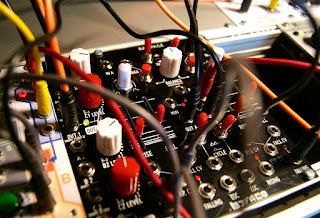
This is the 36th article on this blog. I kept on with my goal to publish one article per month on average. Some months were more prolific than others though.
The blog has now more than 19000 views and 10 comments. 21% of the audience comes from the USA. The most popular article is the one on the Output module with 1200 views.

Since August 2018, Bob, a little Lego figure, accompanies me on every article about building something. Initially relegated to cleaning tasks, Bob was able to show some skills in drilling or module tuning. His small size makes him a valuable partner for delicate work.
 There were so many evolutions between the first family photo in September 2017 where my first modules are finally assembled in a 3U Eurorack synthesizer row beginning and now with almost two finished rows of 84HP. The synth includes, from top to bottom from left to right, One ADSR envelope generator, one CV quantizer, two oscillators, two filters, four VCA, one phaser effect, one output module, one sample & hold with noise generator, one slew limiter, two attenuators, a mixer, a voltage reference, a double multiple, one chaotic modulation generator, a signal multiplier with CV offset, a double modulation generator, one random generator and a resonator.
There were so many evolutions between the first family photo in September 2017 where my first modules are finally assembled in a 3U Eurorack synthesizer row beginning and now with almost two finished rows of 84HP. The synth includes, from top to bottom from left to right, One ADSR envelope generator, one CV quantizer, two oscillators, two filters, four VCA, one phaser effect, one output module, one sample & hold with noise generator, one slew limiter, two attenuators, a mixer, a voltage reference, a double multiple, one chaotic modulation generator, a signal multiplier with CV offset, a double modulation generator, one random generator and a resonator.First family photograph, September 2017 :
And nearly 3 years after....

Some of the big steps are detailed here below :
- my first module (August 2017 - built on November 2016) : you have to start somewhere

- the case (February 2018) : modules have a home now

- first kits (May 2018) : I now have nice modulation sources
- repairing my VCO (July 2018) : I finally have a tuned sound source


- Doepfer DIY (September 2018) : comes with my first filter
- Replacing the Doepfer DIY with separated elements (early 2020) : new ADSR, new VCO, new filter.
I learned a lot on this journey into the world of do-it-yourself synthesizers.
First of all, I improved my brazing technique. I can now make denser builds than before.
I've learned how to design module panels. I also tested and approved new suppliers, such as Thonk.
But more importantly I learned how to use the synthesizer, how to use it to create generative music, how to create different types of sounds.
I used the synthesizer to make 21 tracks. Mostly as illustrations of the function of a module for the blog, but not only :
- 11 sound examples of the module at hand;
- 7 sound illustrations of the state of the synthesizer;
- 2 participations to the monthly KVR Music Cafe;
- 1 participation to Audiofanzine Inspired Composition (Compos Inspirées).
And here is the track of the day :
All sound from the modular synthesizer. Too many tracks to detail them all.
Most tracks were performed in a very traditional way for me : first writing and recording a MIDI track, then programming the synth sound and recording the audio using the Korg SQ-1 sequencer as a MIDI to CV converter. Exceptions : drums were made using the SQ-1 as the sequencer and percussion were generated by the Turing Machine.
DAW : Reaper





































